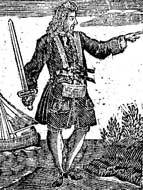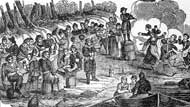Charles Vane

Charles Vane
Charles Vane's pirating career had several somewhat bizarre twists but he was successful and well known at the time, and in particular in 1718. There are not many references to Vane's origins, but his pirating career is said to have begun when he joined other pirates in 1716. During this time, the pirates were raiding Spanish salvage crew and ships that were recovering silver from galleons that sunk in 1715 off the Florida coast. In May 1718, two captains of plundered vessels reported Vane and his crew to Governor Bennett in Bermuda for his piracy. Vane's crew tortured and killed several men on the two Bermuda sloops ( "Diamond" and "William and Martha" ) with only a few hours of one another.
When the new Governor Woodes Rogers arrived on board Delicia with two accompanying man-of-wars (HMS Milford and HMS Rose ) in New Providence offering pardons to pirates in late July 1718, Vane set fire to one of his recent French prize sloops and set sail and took a few shots at the entering man-of-wars as he slipped by them. Vane and his crew were reported to be the only pirates in New Providence that did not accept the pardon at Woodes' arrival. Soon after, Woodes sent
the former pirate Captain Benjamin Hornigold to track down Vane, but Vane was able to loose his pursuers.
A couple of days after his flight, Vane captured a sloop which he kept as a consort and sent Yeats aboard to command. In late August/early September, Vane and his consort were operating off the Carolina coast, and somewhat similar to what Blackbeard did a few months earlier, he attacked shipping entering and leaving Charleston. One of the several ships plundered was a large brigantine from Africa carrying 90 blacks. Outraged by the recent string of pirate attacks outside Charleston, the Governor and Council of South Carolina planned to rid the menacing pirates, in particular Vane, and commissioned two armed sloops led by Colonel William Rhett to find him.
By this time, Vane was successful in plundering many vessels, and Captain Yeats commanding Vane's sloop consort also felt he was becoming a successful pirate. Vane considered his consort and its captain as a subordinate and tender to him and his larger brigantine and made that point clear to the consort. A few days after the capture of the African vessel, Yeats, wanting to finally captain by himself, set sail with "his" sloop while the two ships were at anchor at night. With him were an accompanying crew of about 15 and some of Vane's plunder, including the recently captured blacks.
While off Ocracoke Island, North Carolina in September 1718, Vane met up with the fellow pirate Blackbeard and the pirate ships saluted one another and the two pirate crews proceeded to spend a week together in a typical pirate party. After departing company, Vane continued his plundering successes and hoped to meet with Yeats again, but instead plundered a few more vessels from Charleston.
Colonel Rhett soon afterwards met up with the plundered vessels and was informed by some of the crew that were captured while in company with the pirates that they overheard their guardians say they were planning to sail south. This was just a deception on Vane's part, for he gave orders to his crew to give contrary statements for the other crew to overhear in case such a predicament as this came up. His plan worked, for Rhett sailed south while Vane actually sailed north. In doing so, Rhett was unsuccessful in locating Vane, but unexpectedly discovered and captured another pirate, Major Stede Bonnet instead.

Blackbeard's and Vane's
crew celebrate together
on the Carolina coast
On November 23, Vane encountered a vessel in the Windward Passage and expected little resistance when they rose their pirate flag. But instead, the vessel retaliated with a broadside and it was discovered to be a French man-of-war. At this knowledge, Vane decided to flee the scene and not pursue the fight any longer. Most of the crew felt differently on this matter, but at the time of battle the captain had extreme command. However, the next day after their escape, the crew confronted Vane and stated he was a coward. The crew elected the quarter master, Calico Jack as the new captain of the brigantine and Vane and his fellow supporters were set off on a small sloop.
In the following months, Vane and his new crew started from scratch again quite successfully by plundering several vessels. In February, Vane's sloop was wrecked on an uninhabited island in the Bay of Honduras during a fierce storm where most of the crew drowned, but Vane managed to survive but found himself marooned. Local turtle fishermen who came on canoes helped him survive a day at a time. Finally, a ship arrived but unfortunately for Vane it was commanded by an old acquaintance and former buccaneer Captain Holford. Holford would not rescue Vane from the island stating, "Charles, I shan't trust you aboard my ship, unless I carry you a prisoner; for I shall have you plotting with my men, knock me on the head and run away with my ship a pirating." And with that, Holford sailed away leaving Vane alone again.
Luckily another ship soon arrived and this time no one knew Vane so he was allowed on board. Unluckily, Captain Holford's ship met with this ship and he was invited aboard to dine by the captain. While there, Holford accidentally saw Vane working onboard and quickly informed the captain who Vane truly was. On knowing this, the captain definitely did not want Vane on board, so Holford moved him to his ship but now as a prisoner rather than a free man. Holford turned him over to the authorities in Jamaica where he was soon tried for piracy on March 22, 1720. Subsequently convicted, Vane was hanged at Gallows Point and his body hung in chains at the small islet Gun Cay.
Charles Vane's career was somewhat vibrant - from his open defiance to the new Governor to the unlucky circumstances that led to his capture. Vane was able to escape peruses several times by out sailing or outwitting them, but in the end his capture was almost too easy due to events following the shipwreck.
